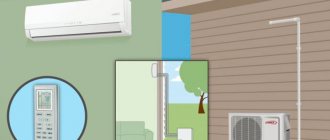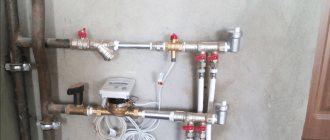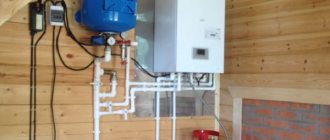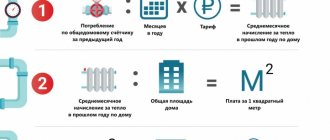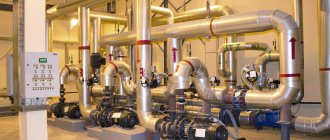A heat meter is a device for recording consumed coolant, which is currently very profitable, as it allows you to save money by paying only for consumed heat, excluding overpayments.
An important point is the correct choice of the type of device depending on the installation location and design features of the heating network, as well as concluding an agreement with a service organization that will monitor the technical condition of the device.
There are many models of heat meters, differing in design and size, but the principle of how a heating meter works remains the same as with a simple device that measures the temperature and water flow at the inlet and outlet of the pipeline of a heating supply facility. Differences appear only in engineering approaches to solving this issue.
Why do you need a heat meter?
Of course, installing a heat consumption meter is beneficial, since the monthly amount for heating will be calculated according to current tariffs and based on readings taken from an individual meter. Thus, the consumer who has installed a thermal energy meter pays only for the services received without any attributions from the utility companies supplying the heat (read also: “How to calculate thermal energy”). In addition, owners have the opportunity to regulate the heating temperature of rooms or utility rooms manually or automatically (subject to the installation of an electronic control system).
Consumers should know that a heat meter does not save energy; it allows you to pay for the energy actually consumed, and not according to approximate calculations obtained as a result of the theoretical development of state standards. Individual heat meters, such as in the photo, allow you to save a significant amount of money on paying for heating services, it can be up to 60%.
Operating principle of an ultrasonic heat meter
This counter is considered one of the most advanced options. It measures the speed of passage of an ultrasonic pulse between sensors located on opposite walls of the pipe. Based on these data, the temperature and water flow rate are calculated. Even with severe contamination of the coolant, the indicators may change very slightly up or down.
Since the meter does not have any elements in the path of the flow, it does not wear out or create additional obstructions, so the pressure does not change after passing through it. However, some models allow you to supplement the meter with automatic shut-off valves, which will open or partially close the pipe to regulate the pressure inside the apartment heating system.
This allows you to automatically regulate the temperature to a comfortable level, so as not to overpay for heating on days when it is significantly warmer outside.
Therefore, ultrasonic meters, being the most unpretentious and reliable, are quite often installed as common meters in the house in order to reduce costs for all residents.
Types of modern heat meters
Commercially available heat meters for heating in an apartment are not one device, but a set of devices. The set may include:
- sensors;
- calculators for the amount of consumed thermal energy;
- flow, pressure and resistance transducers.
The components included in a specific kit are determined and approved for the object individually.
According to the area of application, heat meters for heating are:
- brownie (industrial);
- apartment (individual).
Based on the operating principle, heat metering units are divided into devices:
- mechanical;
- ultrasonic.
Criterias of choice
Let’s figure out what basic criteria are used to select a heat meter:
- certification - the device must be registered in the State Register of Measuring Instruments and checked for accuracy,
- measurement error - it should not be more or less than four percent if the temperature difference is from twenty degrees,
- error when measuring mass - deviations within two percent are allowed here. A significant role is played by the ability of the counter to determine the mass difference,
- flow measurement range - according to the norm, it should be no lower than 1 in 25,
- temperature range – normatively defined as no more than 200 degrees,
- indication of temperature difference measurements - previously the value was at least 10 degrees, for modern models the indicator is set to 3 degrees,
- pressure loss – in the flow converters of heat meters there is resistance to hydraulic pressure,
- length of straight pipes - many types of devices require a significant length before and after the installation point,
- recording pressure and temperature indicators - almost every model has this option for temperature, and for pressure - some,
- measuring channels - meters are measuring systems that carry out a full list of functions for measuring heat and mass, pressure and temperature, and the duration of normal operation.
In addition, when choosing a metering device, the consumer is recommended to clarify what capabilities the heat meter has:
- archive and its depth,
- diagnostic system – independently checks the performance of the heating device,
- availability of communication with a computer,
- energy independence,
- intervals between checks,
- operating conditions for taking readings,
- delivery set,
- warranty periods,
- cost of the device.
When choosing a heating meter, consider its archive and depth
Apartment heat meters
An apartment individual heat meter is a device that has small channel diameters (no more than 20 millimeters) and a range for measuring the amount of coolant of about 0.6-2.5 m³/h. Thermal energy consumption is determined by electromagnetic, vortex or turbine measurement. Based on the name, it is clear that this type of heat meters is installed in apartments and private households. Water is usually used as a coolant, heated to the desired temperature.
An apartment heat meter consists of two complementary devices:
- heat calculator;
- hot water consumption meter.
The operating principle of an individual heat meter is as follows: a heat meter is installed on the water meter and 2 wires are routed, which are equipped with temperature sensors. One wire is connected to the supply pipeline, and the other is also connected to the pipeline, but leaving the room. Using a hot water meter, the volume of coolant used for heating is recorded. Using a special calculation technique, the heat meter calculates the amount of heat consumed.
How to convey testimony correctly
An apartment heat meter is functionally much simpler than a modern mobile phone, but users periodically have misunderstandings about the process of taking and sending display readings.
To prevent such situations, before starting the procedure for taking and transmitting readings, it is recommended to carefully study its passport, which provides answers to most questions related to the characteristics and maintenance of the device.
Depending on the design features of the device, data is collected in the following ways:
- From the liquid crystal display by visually capturing readings from various menu sections, which are switched by a button.
- ORTO transmitter , which is included in the basic package of European devices. The method allows you to display and print extended information about the operation of the device on a PC.
- The M-Bus module is included in the delivery of individual meters in order to connect the device to the centralized data collection network of heat supply organizations. Thus, a group of devices is combined into a low-current network using a twisted pair cable and connected to a hub, which periodically polls them. Afterwards, a report is generated and delivered to the heat supply organization, or displayed on a computer display.
- The radio module included in the delivery of some meters transmits data wirelessly over a distance of several hundred meters. When the receiver comes within range of the signal, the readings are recorded and delivered to the heat supply organization. Thus, the receiver is sometimes attached to a garbage truck, which, as it follows a route, collects data from nearby meters.
Archiving of readings
All electronic heat meters store in the archive data on accumulated indicators of thermal energy consumption, operating and idle time, coolant temperature in the forward and return pipelines, total operating time and error codes.
As standard, the device is configured for various archiving modes:
- hourly;
- daily;
- monthly;
- annual.
Some of the data, such as total operating time and error codes, can only be read using a PC and special software installed on it.
Heat meters for heating in an apartment - how to choose and install correctly?
To avoid problems with paying receipts, it is necessary to submit water meter readings in a timely manner; how to do this correctly, read on.
Calculation of heat from underfloor heating, detailed article -
Transfer of readings via the Internet
One of the most convenient ways to transmit readings of consumed thermal energy to institutions for its accounting is transmission via the Internet. Its convenience and practicality lies in the ability to independently control payments and debts, as well as track heat consumption at different periods without standing in queues and spending a small amount of time.
To do this, you must have a personal computer connected to the network and the address of the website of the controlling organization, as well as the login and password of your personal account, after logging into which a form for entering readings will open. To prevent disagreements from arising in the event of a possible failure or malfunction on the site, it is advisable to take “screenshots” of the screen after entering information.
Mechanical heat meters
Mechanical (or tachometer) heat energy meters shown in the photo are simple units. They usually include a heat meter and a rotary water meter. The principle of how this type of heating meter works is as follows: for convenience and accuracy of measurement, the translational movement of the coolant liquid turns into a rotational one.
A mechanical (tachometer) meter is a very economical purchase, but the cost of filters should be added to its price. As a result, the kit will cost the consumer about 15% less than other types of heat meters, but provided that the pipeline diameter does not exceed 32 millimeters.
Mechanical devices have a significant drawback - they cannot be used when the coolant (water) has a high degree of hardness and if it contains particles of rust, scale or scale, since they clog filters and flow meters.
Electromagnetic heating meter
This is an expensive model of thermal devices, and is one of the most precise devices. The principle of operation of an electromagnetic meter is that the coolant passes through the device, while the electromagnetic field conducts a weak current. This device needs to be maintained, that is, cleaned periodically.
Rice. 4 Electromagnetic heat meters
The electromagnetic device consists of 3 main parts:
- Primary converter;
- An electronic unit that can operate both from batteries and from the mains;
- Temperature sensors.
In this case, the electromagnetic heat device can be installed in any position (horizontal, vertical, or at an angle), but this is only in the case when the area where the meter is installed is constantly filled with coolant.
If the diameter of the pipe does not match the diameter of the device flange, then adapters can be used.
Ultrasonic heat meters
Manufacturers offer consumers a large selection of models of ultrasonic heat meters. True, the principle of operation for all of them is almost the same: two devices are installed opposite each other on the pipe - an emitter and a device that receives ultrasonic signals. The emitter sends a special signal through the coolant flow and after a while the receiver receives it. The time interval between emission and reception of the signal depends on the speed of movement of water through the pipeline. When the time is known, the coolant flow is calculated.
In addition to its main functions, an ultrasonic heat meter can regulate the supply of thermal energy. These thermal energy metering devices are distinguished by greater accuracy of readings, they are more reliable and durable than tachometer devices.
Installation of heat energy meters
According to experts, the best solution to the question of where to install a meter is to install a common house heat meter. Then all consumers living in the house will not have to pay for thermal energy, which was not actually supplied to the building. But the cost of a common house heating meter is quite high. True, if you divide it by the number of apartments, it will be quite affordable. To install a communal heat meter, you will first need to hold a general meeting of residents, document the decision made (draw up and sign a protocol) and submit an application to the management company with a request to connect the unit. After the heat meter is installed, you will need a person from among the consumers responsible for timely taking readings from the device and issuing receipts for each apartment.
If not all residents of the house or entrance agree to install a heat meter, then the apartment owner should think about how to significantly reduce the financial costs of individual heating of their own home.
Design and principle of operation
The basis of a water meter with a temperature sensor is the same as a regular one. When the pressure is turned on, the impeller rotates, the revolutions of which are read and converted by the water meter itself into units of volume. In the classic version - cubic meters. In the case of a flow meter with a temperature sensor, the consumption of hot water is taken into account. More subtle mechanisms come into force. The hot water temperature is taken into account continuously. The temperature sensor takes measurements and consumption is calculated.
According to existing rules, the consumption of water resources is fully paid only for heat of 50 degrees and above. If it is 45-49, then you have to pay 90% of the amount spent, if it is colder - 40-44 degrees Celsius, then 70%. Everything that, according to the temperature sensor, has a temperature below 40 degrees is calculated as cold.
This is an excellent opportunity to save on formally hot water using a temperature sensor. Citizens are deterred by the cost of a water appliance with a temperature sensor, because its price is sometimes several times higher than the market average replacement costs, for example (including the work of a technician, the cost of the device, and the journey to the apartment). The profit from the purchase will not be comparable to the losses. Continuing to pay for barely warm water at unreasonably high prices, the consumer loses more money and nerves - from the understanding that he will pay money again.
On the display of a meter with a temperature sensor it will be written in detail and clearly how much was spent. The information content of the displays depends on the complexity of the model with a temperature sensor, but even the simplest one will provide comprehensive information. The Profit RMD water meter model is in demand among city residents.
Installation of an individual heat meter
Before installing a heating meter in a separate apartment of a multi-storey building, a number of measures and actions will need to be completed, otherwise connecting the device will not be appropriate or legal. Step one
.
It is necessary to eliminate existing sources of heat loss, including cracks in windows, insufficiently insulated entrance doors, and frozen corners. Only after this the installation of a heat meter will result in significant savings. Step two
.
The management company (housing office, homeowners' association) must provide the apartment owner with technical conditions (TU) - they contain the requirements that must be met in order to connect an apartment heat meter. Typically, the text of the conditions takes up an A4 sheet. It certainly contains information about the temperature and pressure of the coolant entering the pipeline of a particular house. Step three
. Knowing these parameters, you can start purchasing a heat meter from a company that operates legally. When purchasing a device, you must request a sales and cash receipt, a certificate confirming quality, rules and operating instructions.
Step four
.
Based on the technical specifications provided by the management company, you should order a design solution for installing a heat meter in an apartment from the design organization. The design company must have a license for this type of work. Step five
.
The thermal measuring device is installed by employees of a licensed organization specializing in this type of service. When choosing a company, it is advisable to pay attention to a number of nuances:
- for the availability of information about the organization in the Unified State Register of Legal Entities;
- for the availability of a package of necessary documentation, including certificates, SRO approvals;
- availability of qualified specialists;
- for the availability of special equipment;
- to perform a full list of installation works;
- for the availability of a free specialist visit to the client’s apartment to inspect communications;
- for the presence of warranty obligations for the work performed.
Step six
. When the installation of the heat meter is completed, a representative of the management company (housing office, homeowners' association) must seal it and sign the acceptance certificate for the device. To make his life easier, the apartment owner has the right to order all of the above work in one place - from a company that provides this type of service at a professional level, however, for this you will have to pay a considerable amount. If you have the desire and free time, you can prepare the installation documents yourself.
In what cases is installation impossible or irrelevant?
It is impossible to say unequivocally about relevance. However, there are special cases when the use of the device due to technical parameters is impossible.
There are old houses that are recognized as unsafe or are undergoing the procedure for recognizing them as such. In such buildings, such costs are not justified, and according to the law, owners are exempt from the obligation to use metering devices.
The assurances of resource company representatives that houses with vertical wiring are not suitable for installing individual appliances are a myth. Anything is possible if desired.
Each person has the opportunity to control the consumption of the resource received and plan a budget. Savings with a heat meter alone are up to 30%, which is a considerable amount if multiplied by 12 months. Any costs for purchasing and installing meters will pay off handsomely.
Which water meter is better to install in an apartment? The answer is in our article.
Checking heat meters
Typically, new devices are sold with an initial test, which is carried out at the factory that produces them. Proof that the verification of heat meters has been carried out is the presence of a special sticker corresponding to the entry, a special mark, both on the devices and in the documents attached to them. During operation, verification of heating meters is carried out at the expense of apartment owners once every 4 years; to carry it out, you must contact a number of organizations and institutions:
- to the Rostest department;
- to a company that has the appropriate authority to carry out the inspection;
- to the service center of the manufacturer.
They independently take readings from the heating meter in the same way as from the electric meter. The payment receipt indicates the difference in readings, multiplies it by the established tariff and makes the payment, for example, in one of the Sberbank branches. The recipient of the payment is the heat supply organization.
Heat meters - installation advantages, detailed video:
Is there any benefit
Users who have installed a heat meter for their apartment note a number of advantages and disadvantages.
The advantages include the following:
- Saving money if the house has no heat leaks and meets all energy efficiency standards.
- The ability to control the temperature by reducing the heating by closing the shut-off valve. As a result, heat consumption is reduced, which immediately has a positive effect on cost savings.
An individual heat meter relieves the owner of an apartment in multi-storey buildings from paying the tariff calculated according to the standard.
Among the disadvantages, the following points can be noted:
- High price. Installation, like the device itself, is expensive, especially if it needs to be mounted on each battery.
- The need for regular inspection , which does not come free.
- Such units often fail , since their performance is negatively affected by many factors, which are sometimes impossible to eliminate. One of the main causes of breakdowns is an outdated heating system, which contains many dirty elements.
If there is no building-wide heat meter and not all apartment owners have installed individual meters, it will not be possible to calculate payments for the device.
Before purchasing and installing a heat sensor, you need to weigh the pros and cons, evaluate the technical capabilities of the device and compliance with regulations established at the legislative level.
Restrictions on installing a heat meter in an apartment
Many consumers are interested in whether heating meters are installed individually in each apartment? The fact is that in most domestic apartment buildings, when creating a heating system, vertical riser wiring is used, which prevents the installation of one apartment meter. In such a situation, there is only one solution - to install meters on heating radiators, but such a solution is difficult to implement for the following reasons:
- installing several heating appliances in one apartment will cost its owners a tidy sum, since each meter for a heating battery costs a lot of money;
- Taking readings from each device is made difficult by the fact that utility workers are not able to walk through all the rooms in the apartments of the house on a monthly basis to record the data. When doing this work yourself, you can get confused in the numbers and make mistakes in the calculations;
- presence of maintenance problems - several devices are much more difficult to control and verify their correct functioning;
- The meter for a heating radiator has poor accuracy, since the difference at its input and output is so small that the device is often unable to record it.
A way out of this situation can be the installation of special distributors that measure the flow rate of the coolant liquid, based on the temperature difference between the surface of the radiator and the air in the room. The cost of one such device is quite affordable for the consumer.
In buildings erected after 2000, horizontal distribution of the heating system is used, so in such apartments it is enough to install one heat energy consumption meter, and no distributors are required.
As a result of the above measures, it is possible to significantly reduce monthly payments for services provided by utility companies through the installation of heat meters.
General rules for reading and calculating data
For a service provider company, one indicator is important - the amount of heat energy used during the reporting period (usually per month). Payment is calculated based on this indicator. Accordingly, at the end of the reporting period it is necessary to take readings and make a calculation.
On the front panel of the heat meter there is an electronic information board on which all parameters are displayed. The first is the amount of accumulated heat energy. Necessary:
- write down readings from the screen;
- Subtract from this figure the readings taken in the previous reporting period. This will be the amount of heat energy used for the current period.


